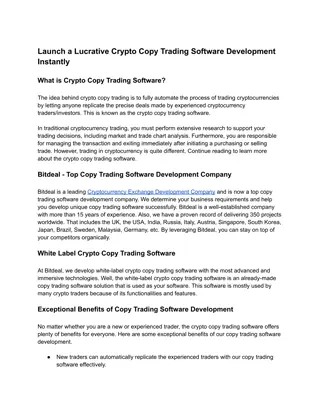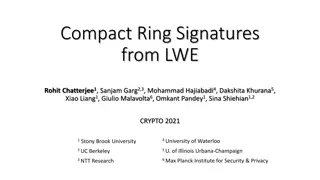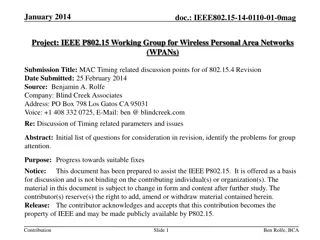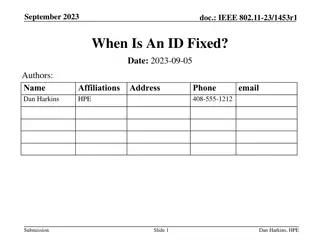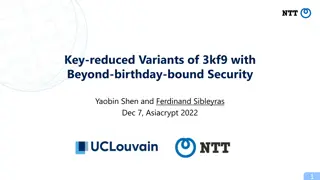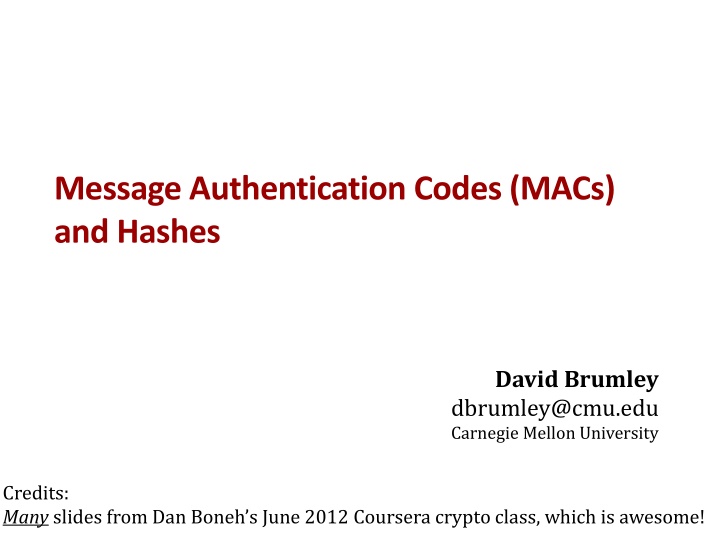
Message Authentication Codes (MACs) and Hashes in Cryptography
Explore the concepts of message authentication codes (MACs) and hashes in cryptography as detailed by David Brumley from Carnegie Mellon University. Discover the importance of integrity in message transmission and the role of MACs in ensuring data security. Learn about cryptographic principles, examples of message integrity goals, and the vulnerability of CRC in message authentication. Dive into the function and significance of MACs through practical examples of securing stock ticker updates and detecting file modifications using Tripwire.
Uploaded on | 2 Views
Download Presentation

Please find below an Image/Link to download the presentation.
The content on the website is provided AS IS for your information and personal use only. It may not be sold, licensed, or shared on other websites without obtaining consent from the author. If you encounter any issues during the download, it is possible that the publisher has removed the file from their server.
You are allowed to download the files provided on this website for personal or commercial use, subject to the condition that they are used lawfully. All files are the property of their respective owners.
The content on the website is provided AS IS for your information and personal use only. It may not be sold, licensed, or shared on other websites without obtaining consent from the author.
E N D
Presentation Transcript
Message Authentication Codes (MACs) and Hashes David Brumley dbrumley@cmu.edu Carnegie Mellon University Credits: Many slides from Dan Boneh s June 2012 Coursera crypto class, which is awesome!
Recap so far Information theoretically secure encryption: ciphertext reveals nothing about the plaintext Secure PRNG: Given first k output bits, adversary should do not better than guessing bit k+1 Principle: next bit is secure, not just random looking output Secure PRF: Adversary can t tell the difference between real random function and PRF Principle: computationally indistinguishable functions Semantic security (computationally secure encryption): Adversary picks m0,m1, receives encryption of one of them, can t do better than guessing on which messages was encrypted. Principle: ciphertext reveals no information about plaintext Security is not just about keeping key private 2
Message Integrity Goal: integrity (not secrecy) Examples: Protecting binaries on disk. Protecting banner ads on web pages Security Principles: Integrity means no one can forge a signature 3
CRC message tag V Bob Alice S Verify tag: CRC(m, tag) ?= yes Generate tag: tag CRC(m) Is this Secure? No! Attacker can easily modify message m and re-compute CRC. CRC designed to detect random errors, not malicious attacks. 4
Message Authentication Codes (MAC) message tag V Bob Alice S k k secret key required Defn: A Message Authentication Code (MAC) MAC = (S,V) defined over (K,M,T) is a pair of algorithms: S(k,m) outputs t in T V(k,m,t) outputs `yes or `no V(k, m, S(k,m)) = yes (consistency req.) 5
Example Authorized Stock Ticker Publisher 1. k = KeyGen(l) 2. For each price update: t = S(stock||price,k) Publish V Consume Adversary A secure MAC should prevent this t = A(stock||price up) e.g., to cause a buying frenzy 6
Example: Tripwire At install time, generate a MAC on all files: filename filename filename F1 F2 Fn t1 = S(k,F1) t2 = S(k,F2) tn = S(k,Fn) Later a virus infects system and modifies system files User reboots into clean OS and supplies password Then: secure MAC all modified files will be detected
Secure MAC Game Challenger Adversary A 1. k = KeyGen(l) m1,...,mq 2. Picks m1, ..., mq 3. Compute i in 1...q: ti = S(mi, k) t1,...,tq m,t 4. picks m not in m1,...,mq Generates t 5. b = V(m,t,k) existential forgery if b= yes b = {yes,no} Security goal: A cannot produce a valid tag on a message Even if the message is gibberish 8
Secure MAC Game Challenger Adversary A 1. k = KeyGen(l) m1,...,mq 2. Picks m1, ..., mq 3. Compute i in 1...q: ti = S(mi, k) t1,...,tq m,t 4. picks m not in m1,...,mq Generates t 5. b = V(m,t,k) b = {yes,no} Def: I=(S,V) is a secure MACif for all efficient A: AdvMAC[A,I] = Pr[Chal. Outputs yes ] < 9
Let I = (S,V) be a MAC. Suppose an attacker is able to find m0 m1 such that S(k, m0) = S(k, m1) for of the keys k in K Can this MAC be secure? 1. Yes, the attacker cannot generate a valid tag for m0 or m1 2. No, this MAC can be broken using a chosen msg attack 3. It depends on the details of the MAC 1. A sends m0, receives (m0, t0) 2. A wins with (m1, t0) 3. Adv[A,I] = since prob. of key is .
Secure PRF implies secure MAC For a PRF F: K X Y, define a MAC IF = (S,V) as: S(k,m) = F(k,m) V(k,m,t): if t = F(k,m), output yes else no m, tag V Bob Alice S accept msg if tag = F(k,m) tag F(k,m) Attacker who knows F(k,m1), F(k,m2), ..., F(k, mq) has no better than 1/|Y| chance of finding valid tag for new m 12
Security Thm: If F: K X Y is a secure PRF and 1/|Y| is negligible (i.e., |Y| is large), then IF is a secure MAC. In particular, for every eff. MAC adversary A attacking IF, there exists an eff. PRF adversary B attacking F s.t.: AdvMAC[A, IF] = AdvPRF[B, F] + 1/|Y| A can t do better than brute forcing 13
Proof Sketch Let f be a truly random function Challenger Adversary A m1,...,mq 2. f from FUNS[X,Y] 3. Calculates ti = f(k, mi) 1. Picks m1, ..., mq t1,...,tx 4. picks m not in m1,...,mq. Generates t m,t b A wins iff t=f(k,m) and m not in m1,...,mq PR[A wins] = Pr[A guesses value of rand. function on new pt] = 1/|Y| 14
Question Suppose F: K X Y is a secure PRF with Y = {0,1}10 Is the derived MAC IF a practically secure MAC system? 1. Yes, the MAC is secure because the PRF is secure 2. No tags are too short: guessing tags isn t hard 3. It depends on the function F Adv[A,F] = 1/1024 (we need |Y| to be large) 15
Secure PRF implies secure MAC S(k,m) = F(k,m) Assuming output domain Y is large So AES is already a secure MAC.... ... but AES is only defined on 16-byte messages 16
Building Secure MACs Given: a PRF for shorter messages (e.g., 16 bytes) Goal: build a MAC for longer messages (e.g., gigabytes) Construction examples: CBC-MAC: Turn small PRF into big PRF HMAC: Build from collision resistance (Others not covered: NMAC/PMAC) 17
Construction 1: Encrypted CBC-MAC (ECBC-MAC) raw CBC m[0] m[1] m[3] m[4] IV assume 0 F(k, ) F(k, ) F(k, ) F(k, ) Why? <= L means any length tag Let F: K X Xbe a PRP Define new PRF FECBC : K2 X L X F(k1, ) 18
Attack Suppose we define a MAC IRAW = (S,V) where S(k,m) = rawCBC(k,m) Then IRAW is easily broken using a 1-chosen msg attack. Adversary works as follows: 1. Choose an arbitrary one-block message m X 2. Request tag for m. Get t = F(k,m) 3. Output t as MAC forgery for the 2-block message m|| t m 19
Attack Break in 1-chosen message attack t m m m IV IV m F(k, ) F(k, ) F(k, ) t t Problem: rawCBC(k, m|| t m ) = F(k, F(k,m) (t m) ) = F(k, t (t m) ) = F(k,m) = t 20
ECBC-MAC analysis Recall: We built ECBC-MAC from a PRP (e.g., block cipher) F: K x X -> X Theorem: For any L>0, For every eff. q-query PRF adv. A attacking FECBC there exists an eff. adversary B s.t.: AdvPRF[A, FECBC] AdvPRP[B, F] + 2 q2 / |X| CBC-MAC is secure as long as q << |X|1/2 After signing |X|1/2 messages, rekey 21
Implications # msgs MAC ed with key AdvPRF[A, FECBC] AdvPRP[B, F] + 2 q2 / |X| Suppose we want AdvPRF[A, FECBC] 1/232 128-32 = 96 q2 = 248*2 = 296. then (2q2 /|X|) < 1/232 AES: |X| = 2128 q < 248 3DES: |X| = 264 q < 216 Must change key after 248, 216 msgs 22
Extension Attack Suppose the underlying PRF F is a PRP (e.g., AES). Let FBIG be ECBC. Then FBIG has the following extension property: x,y,w: FBIG(k, x) = FBIG(k, y) FBIG(k, x||w) = FBIG(k, y||w) m[0] ... w F(k,x||w) = F(k,y||w) here F(k,x) = F(k,y) here k0 F F F Attacker just needs to find such an x and y 23
Birthday Paradox Put n people in a room. What is the probability that 2 of them have the same birthday? Pn P2 P1 P4 P3 Rule of Thumb: N possibilities, and j random samples Pr[collision] 50% when j = sqrt(N) PR[Pi = Pj] > .5 with 23 people. (Think: n2 different pairs) 25
Generic attack on hash functions Let H: M {0,1}n be a hash function ( |M| >> 2n ) Generic alg. to find a collision in time O(2n/2) hashes Algorithm: 1. Choose 2n/2random messages in M: m1, , m2n/2 (distinct w.h.p ) 2. For i = 1, , 2n/2 compute ti = H(mi) {0,1}n 3. Look for a collision (ti = tj). If not found, got back to step 1. How well will this work? 26
The birthday paradox Let r1, , ri {1, ,n} be indep. identically distributed integers. Thm: when i= 1.2 n1/2then Pr[ i j: ri = rj] If H: M-> {0,1}n, then Pr[collision] ~ with n1/2 hashes 27
B=106 50% prob of collision with ~1200 hashes # samples n 28
Recall # msgs MAC ed with key AdvPRF[A, FECBC] AdvPRP[B, F] + 2 q2 / |X| Suppose we want AdvPRF[A, FECBC] 1/232 then (2q2 /|X|) < 1/232 AES: |X| = 2128 q < 247 3DES: |X| = 264 q < 215 Must change key after 247, 215 msgs Reason: the Birthday Paradox. 29
Generic attack Let FBIG: K x M Y be a MAC with the extension property (e.g., CBC-MAC): FBIG(k, x) = FBIG(k, y) FBIG(k, x||w) = FBIG(k, y||w) 1. For i = 1, , 2n/2 get ti = F(k, mi,) 2. Look for a collision (ti = tj). (birthday paradox) If not found, got back to step 1. 3. Choose some w and for query t = FBIG(mi || w) 4. Output forgery (mj||w, t) 30
Implications AdvPRF[A, FECBC] AdvPRP[B, F] + 2 q2 / |X| Suppose we want AdvPRF[A, FECBC] 1/232 then (2q2 /|X|) < 1/232 AES: |X| = 2128 q < 247 3DES: |X| = 264 q < 215 Need PRF that can quickly change keys. 31
Padding 32
What if msg not a multiple of block size? Recall CBC-MAC m[0] m[1] m[3] m[4] ??? F(k, ) F(k, ) F(k, ) F(k, ) tag F(k1, ) 33
CBC MAC padding Idea: pad m with 0 s m[0] m[0] m[1] m[1] 0000 Is the resulting MAC secure? $100 00 Yes, the MAC is secure $10 000 It depends on the underlying MAC Same Tag No Problem: given tag on msg m attacker obtains tag on m||0 because pad(m) = pad(m||0) 34
CBC MAC padding two distinct messages map to two distinct paddings For security, padding must be one-to-one (i.e., invertible)! m0 m1 pad(m0) pad(m1) ISO: pad with 1000 00 . Add new dummy block if needed. The 1 indicates beginning of pad. If m is same as block size, add 1 block pad for security m[0] m[1] m[0] m[1] 1000 m[0] m[1] m[0] m[1] 1000000000 35
HMAC (Hash-MAC) Most widely used MAC on the Internet. function. but, we first we need to discuss hash 37
Collision Resistance Let H: X Y be a hash function ( |X| >> |Y| ) A collision for H is a pair m0 , m1 M such that: H(m0) = H(m1) and m0 m1 A function H is collision resistant if for all (explicit) eff algs. A: AdvCR[A,H] = Pr[ A outputs collision for H] is negligible . Example: SHA-256 (outputs 256 bits) 39
General Idea k2 m tag h PRF k1 Hash then PRF construction 40
MACs from Collision Resistance Let I = (S,V) be a MAC for short messages over (K,M,T) (e.g. AES) Let H: X Y and S: K x Y T (|X| >> |Y|) Def: Ibig = (Sbig , Vbig ) over (K, Xbig, Y) as: Sbig(k,m) = S(k,H(m)) ; Vbig(k,m,t) = V(k,H(m),t) Thm: If I is a secure MAC and H is collision resistant, then Ibig is a secure MAC. Example: S(k,m) = AES2-block-cbc(k, SHA-256(m)) is secure. 41
MACs from Collision Resistance Sbig(k, m) = S(k, H(m)) ; Vbig(k, m, t) = V(k, H(m), t) Collision resistance is necessary for security: Suppose: adversary can find m0 m1 s.t. H(m0) = H(m1). Then:Sbig is insecure under a 1-chosen msg attack step 1: adversary asks for t S(k, m0) step 2: output (m1 , t) as forgery 42
Passwords How do we save passwords on a system? Idea 1: Store in cleartext Idea 2: Hash Enrollment: store h(password), where h is collision resistant Verification: Check h(input) = stored passwd Is this enough to be secure 45
Brute Force Online Brute Force Attack: input: hp = hash(password) to crack for each i in dictionary file if(h(i) == hp) output success; Time Space Tradeoff Attack: precompute: h(i) for each i in dict file in hash tbl input: hp = hash(password) check if hp is in hash tbl rainbow tables 46
Salts Enrollment: 1. 2. compute hp=h(password + salt) store salt || hp Verification: 1. 2. Look up salt in password file Check h(input||salt) == hp What is this good for security, given that the salt is public? Salt doesn t increase security against online attack, but does make tables much bigger. 47
Merkle-Damgard How to construct collision resistant hash functions http://www.merkle.com/ 48
Compression Function K M h M A compression function mixes two fixed length inputs and produces a single fixed length output of the same size as one of the inputs 49
The Merkle-Damgard iterated construction m[0] m[1] m[2] m[3] ll PB IV H(m) (fixed) h h h h H0 H1 H2 H3 H4 Given h: T X T (compression function) we obtain H: X L T . Hi - chaining variables PB: padding block 1000 0 ll msg len If no space for PB add another block 64 bits 50
Security of Merkle-Damgard Thm: if h is collision resistant then so is H. Proof Idea: via contrapositive. Collisions on H collision on h Suppose H(M) = H(M ). We build collision for h. 51
Compression from a block cipher E: K {0,1}n {0,1}na block cipher. The Davies-Meyer compression function h(H, m) = E(m, H) H mi E Hi Thm: Suppose E is an ideal cipher (collection of |K| random perms.). Finding a collision h(H,m)=h(H ,m )takes O(2n/2) evaluations of (E,D). Best possible !! 52









